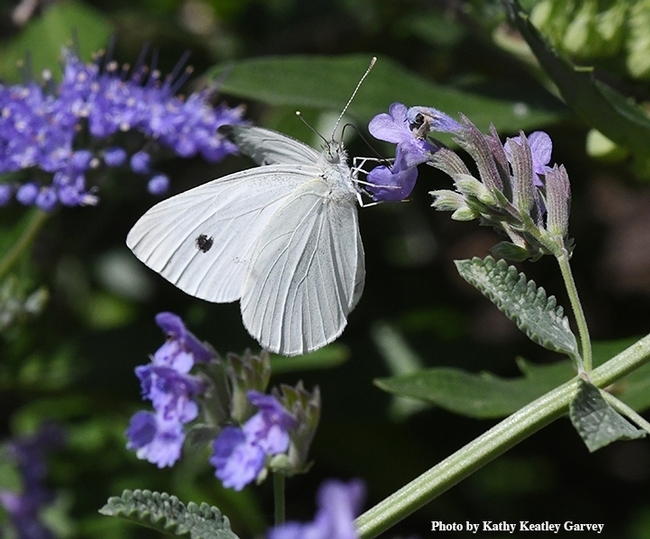No suds for a bug in 2021.
Due to the COVID-19 pandemic precautions, butterfly guru Art Shapiro, UC Davis distinguished professor of evolution and ecology, won't be hosting his annual Beer-for-a-Butterfly Contest, which he launched in 1972 as part of his scientific research to determine the first flight of the cabbage white butterfly, Pieris rapae.
Or, as he says, the contest is in "diapause."
The traditional rules: if you collect the first live cabbage white butterfly of the year in the three-county area of Sacramento, Solano and Yolo, and deliver it to 2320 Storer Hall, UC Davis campus, from 8 a.m. to 5 p.m., Monday through Friday (and detail the exact time, date and location of your capture), and it's judged the winner, you win a pitcher of beer or its equivalent.
Since 1972, the first flight has varied from Jan. 1 to Feb. 22, averaging about Jan. 20.
Who won in 2020? Technically, there was no winner, as Shapiro didn't collect the one he spotted in Winters at 11:16 a.m. on Jan. 30, 2020 at the Putah Creek Nature Park. "It flew back and forth across Putah Creek and then departed the area, flying out of reach above the trees," he noted. He waited around for 90 minutes to see if it would return. It did not.
No one else came forth with a cabbage white so the date of Jan. 30 stands as the first of 2020.
The point of the contest "is to get the earliest possible flight date for statistical purposes," the professor related. "The rules require that the animal be captured and brought in alive to be verified. That way no one can falsely claim to have seen one, or misidentify something else as a cabbage white."
Shapiro, who maintains a research website at http://butterfly.ucdavis.edu, has been defeated only four times, and all by UC Davis graduate students: Jacob Montgomery in 2016; Adam Porter in 1983; and Sherri Graves and Rick VanBuskirk each defeated him in the late 1990s.
In 2019. Shapiro collected the first cabbage white butterfly near the Suisun Yacht Club, Suisun City, Solano County, at 1:12 p.m., Friday, Jan. 25. "It was the earliest recorded in Suisun City in 47 seasons."
In recent years, most winners collected the butterflies in Yolo County:
- 2018: Jan. 19: Art Shapiro collected the winner in West Sacramento, Yolo County
- 2017: Jan. 19: Art Shapiro collected the winner on the UC Davis campus
- 2016: Jan. 16: Jacob Montgomery, UC Davis graduate student, collected the winner in west Davis
- 2015: Jan. 26: Shapiro collected the winner in West Sacramento
- 2014: Jan. 14: Shapiro collected the winner in West Sacramento
- 2013: Jan. 21: Shapiro collected the winner in West Sacramento
- 2012: Jan. 8: Shapiro collected the winner in West Sacramento
- 2011: Jan. 31: Shapiro collected the winner in Suisun, Solano County
- 2010: Jan. 27: Shapiro collected the winner in West Sacramento
The butterfly inhabits vacant lots, fields and gardens where its host plants, weedymustards, grow. In its larval stage, it's known as the importedcabbageworm, and is a major pest of cole crops, including cabbage, broccoli, Brussels sprouts, cauliflower, collards, kale, and kohlrabi. The larvae "chew large, irregular holes in leaves, bore into heads, and drop greenish brown fecal pellets that may contaminate the marketed product, according to the UC Statewide Integrated Pest Management Program (UC IPM) Pest Management Guidelines. "Seedlings may be damaged, but most losses are due to damage to marketed parts of the plant."
"The adult cabbage butterfly is white with one to four black spots on the wings; they are often seen fluttering around the fields," UC IPM says. "The whitish, rocket-shaped eggs are laid singly on the undersides of leaves. The cabbageworm is active throughout the year in California."
Bottom line: COVID canceled the 2021 scientific contest for Pieris rapae ("on your mark, get set, don't go!) but it can't cancel an adult's preference for beer. A beer for no butterfly?
And by the way, Professor Shapiro says "I will gladly accept records. I will neither sample nor go out for a beer until I'm vaccinated." (Email him at amshapiro@ucdavis.edu)
Attached Images:
